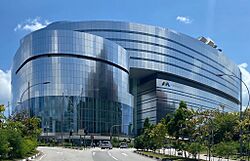Mediacorp facts for kids

Flat version of the 2015 logo, used as the primary logo since 2023.
|
|

The Mediacorp Campus at One-north
|
|
| State-owned | |
| Industry | |
| Predecessors |
|
| Founded | 1 June 1936 |
| Headquarters | 1 Stars Avenue (Mediapolis@onenorth),
Singapore
|
|
Area served
|
Worldwide |
|
Key people
|
Niam Chiang Meng (chairman) Tham Loke Kheng (CEO) |
| Products |
|
| Services |
|
| Revenue | |
|
Number of employees
|
3,000 (2022) |
| Parent | Temasek Holdings |
Mediacorp Pte. Ltd. is Singapore's main media company. It is owned by Temasek Holdings, which is an investment company of the Government of Singapore. Mediacorp runs television channels, radio stations, and digital media websites. Its main office is in the Mediapolis area in Queenstown's One-north district. This new location replaced Caldecott Hill in 2015, which was its home for a long time. In 2022, Mediacorp had over 3,000 employees.
Mediacorp is one of two big media groups in Singapore, along with SPH Media Trust. The company became what it is today in 1999. Before that, one of its earlier forms, the Singapore Broadcasting Corporation (SBC), became a private company in 1994.
Mediacorp is the only company that broadcasts free-to-air TV channels in Singapore. It has six channels that broadcast in Singapore's official languages: English (Channel 5 and the news channel CNA), Mandarin Chinese (Channel 8 and Channel U), Malay (Suria), and Tamil (Vasantham). It also has a streaming service called meWatch. Mediacorp also runs eleven radio stations and the websites Today and 8days. These two used to be print magazines.
For a short time in the early 2000s, another company called SPH MediaWorks also had TV channels. But in 2004, SPH sold MediaWorks to Mediacorp. In return, SPH got shares in Mediacorp's TV and publishing businesses. Only SPH's Chinese channel, Channel U, continued under Mediacorp. SPH later sold its shares in Mediacorp in 2017.
Contents
- How Mediacorp Started and Grew
- What Mediacorp Offers
- Mediacorp Partner Network
- Popular Shows
- Production
- Awards and Achievements
- Images for kids
How Mediacorp Started and Grew
Early Days of Radio and TV (1925–1965)
First Radio Broadcasts
Radio broadcasting in Singapore began in April 1925. A group called the Amateur Wireless Society of Malaya (AWSM) started sending out shortwave radio signals. In 1930, the Singapore Port Authority also began shortwave broadcasts. The Empire Service of the British Broadcasting Corporation (BBC) started in 1932, broadcasting to English speakers across the British Empire.
In 1933, Radio ZHI became Singapore's first professional shortwave radio station. It was very popular but closed in 1936. This happened because the British Malaya Broadcasting Corporation was given the only right to broadcast radio.
British Malaya Broadcasting Corporation (BMBC)
The British Malaya Broadcasting Corporation (BMBC) was formed in 1935 and started broadcasting on June 1, 1936. Its studios and transmitters were officially opened at Caldecott Hill in March 1937. The station aimed to reach 10,000 listeners.
BMBC faced money problems and cut its broadcasting hours in 1937. It also had to reduce the number of artists who were paid. In 1938, BMBC launched a shortwave station called ZHP. This station reached a wider audience, including places like Sarawak and Borneo. This wider reach allowed BMBC to broadcast more live sports events.
Changes During Wartime
In 1940, the British government took over BMBC and renamed it the Malaya Broadcasting Corporation (MBC). During World War II, from 1942 to 1945, the Japanese army took over Singapore. They renamed the radio station Syonan Hoso Kyoku, or Syonan Broadcasting Station (SBS). Broadcasts under Japanese control started in March 1942.
Radio Singapore Begins
After the war, the British took back control. In December 1945, two separate radio stations were introduced: the Blue Network (English and Malay) and the Red Network (Tamil, Hindustani, and Chinese dialects).
On April 1, 1946, Radio Malaya Singapore was set up. It aired news, information, and entertainment. In 1951, Chinese programs got their own station, the Green Network. When Singapore became self-governing in 1959, Radio Singapura took over. It had separate stations for English, Malay, and Mandarin listeners, plus a time slot for Tamil speakers.
When Singapore joined Malaysia in 1963, Radio Singapura became "Radio Malaysia (Singapura)".
Television Arrives in Singapore
Plans for television started after Singapore gained self-government in 1959. Television Singapura was founded on April 4, 1961.
Test broadcasts for Channel 5 began in January 1963. The first official pilot broadcast was on February 15, 1963. Minister for Culture S. Rajaratnam was the first person to appear on Singapore TV. He said that night "might well mark the start of a social and cultural revolution in our lives." Channel 5 officially started on April 2, 1963. It initially showed programs in all four official languages. Channel 8 started trial broadcasts in August 1963 and regular service in November 1963.
In January 1964, Television Singapura became part of Televisyen Malaysia from Kuala Lumpur. It was renamed "Television Malaysia (Singapura)".
Growing as Radio Television Singapore (1965–1980)
After Singapore left Malaysia in 1965, its radio and TV stations became part of Radio Television Singapore (RTS). RTS was a part of the Ministry of Culture. The network grew and moved to a new Television Centre at Caldecott Hill in August 1966.
An FM radio service started in July 1967. New radio studios were built in 1972 and 1975.
From March 1973, Channel 5 focused on English and Malay programs. Channel 8 focused on Chinese and Tamil programs. In May 1974, the two channels started color test broadcasts. The first live color broadcast was the 1974 FIFA World Cup final in July. Full-time color broadcasts began on November 1, 1977.
Singapore Broadcasting Corporation (1980–1994)
RTS faced problems with its budget and staff. So, in 1979, the government suggested creating a new, independent body called the Singapore Broadcasting Corporation (SBC). The SBC Act was approved in January 1980.
The government officially closed RTS on January 31, 1980, and transferred everything to SBC. SBC introduced "weather girls" for its English news in May 1980. It also started sponsoring the clock before the news to earn more money. In August 1980, SBC changed its TV news format to have two newscasters and more live reports.
On January 1, 1982, SBC renamed its radio stations:
- Radio 1 (English; now Gold 905)
- Radio 2 (Malay; now Warna 942)
- Radio 3 (Chinese; now Capital 958)
- Radio 4 (Tamil and Chinese; now Oli 968)
- Radio 5 (Classical Music; now Symphony 924)
In February 1983, SBC launched Newswatch, a news program for children aged 10 to 14. It aired three times a week for 10 minutes.
On January 31, 1984, SBC launched Channel 12. This new TV service focused on cultural programs. In 1985, SBC began showing parts of Parliament meetings.
On August 3, 1987, SBC started adding financial news to the shortwave versions of Radio 1 and 3. In August 1988, SBC news broadcasts got a new look with the Singapore skyline as the background.
On January 1, 1989, SBC launched two new radio stations: Perfect 10 (English pop music for youth) and YES (Mandarin music). In April 1990, Class 95 started, playing adult contemporary music.
Channel 5 began stereo broadcasting on August 8, 1990. SBC had big plans for the 1990s, including a new studio complex and upgraded equipment.
In 1991, SBC changed its TV channel start-up and closedown videos. These new videos used computer animation and music that matched Singapore's many cultures.
Four of the five numbered SBC radio stations changed their names from late 1991 to early 1992: Radio 2 became Warna, Radio 3 became The City Channel, Radio 4 became Olikkalanjiam, and Radio 5 became Symphony.
In January 1993, SBC added 20 hours of broadcasting time each week for its TV channels. Channel 5 focused on English and Malay shows, Channel 8 on Mandarin and Tamil, and Channel 12 on "serious" programs and sports.
On January 1, 1994, Channel 5 moved its remaining Malay programs to Channel 12 and became an English-only channel. Radio Singapore International (RSI) also launched on February 1, 1994. It was an international radio station broadcasting news and music in English, Malay, Mandarin, and Indonesian.
Becoming Singapore International Media (1994–1999)
On October 1, 1994, SBC became a private company called Singapore International Media (SIM). SIM had four main parts:
- Television Corporation of Singapore (TCS), which ran Channel 5 and 8.
- Radio Corporation of Singapore (RCS).
- Singapore Television Twelve (STV12), which ran Channel 12.
- SIM Communications (SIMCOM).
On September 1, 1995, Channel 8 became a 24-hour channel focusing only on Mandarin programs. Its Tamil programs moved to Prime 12, which was a new version of Channel 12 focusing on many languages. TV12 also launched Premiere 12, which showed arts, culture, documentaries, children's, and sports programs.
In March 1998, it was announced that RCS would launch three new radio stations: NewsRadio 93.8, Inter FM, and a financial radio station. On March 1, 1999, TCS launched Channel NewsAsia (CNA), a local news channel. TCS also started its own film production studio, Raintree Pictures, in August 1998.
Mediacorp Today (1999–Present)
On June 15, 1999, the Singapore International Media group of companies changed its name to Media Corporation of Singapore (MediaCorp).
On January 30, 2000, MediaCorp launched three new channels. Prime 12 and Premiere 12 were relaunched as Suria (Malay-language) and Central (children's, Tamil, and arts programs). Sportscity, a sports channel, also launched. In September 2000, CNA started broadcasting internationally. In November, Today was launched as a free newspaper.
In May 2001, another company, SPH MediaWorks, launched two new TV channels. But in late 2004, SPH merged its TV business with Mediacorp. Channel i was closed, but Channel U continued as a partner to Channel 8.
In July 2005, Mediacorp renewed its agreement with the British Broadcasting Corporation (BBC) to continue broadcasting the BBC World Service Radio. In November 2007, Mediacorp launched HD5, Singapore's first high-definition TV channel.
All Mediacorp radio stations began broadcasting 24/7 from January 1, 2008. In March 2008, Central channel was split into two: Vasantham (full-time Tamil channel) and Okto (children's and arts programs).
Due to changes in technology, Radio Singapore International (RSI) closed down on October 31, 2008.
In 2009, Mediacorp formed a partnership with other broadcasting companies in Southeast Asia called Smart Alliance. In August 2013, Mediacorp combined its Malay TV channel (Suria) and two Malay radio stations (Warna 942 and Ria 897) into a new Malay Broadcast Division.
New Headquarters and Digital Focus
On December 8, 2015, Mediacorp officially opened its new headquarters at one-north's Mediapolis. The new building has four studios, a large theater, and a modern newsroom. Along with the new building, Mediacorp also revealed a new logo.
In April 2017, Mediacorp stopped printing the weekend editions of Today newspaper. The weekday editions were also stopped in September 2017, making Today a digital-only publication. In September 2018, 8 Days and i-Weekly magazines also stopped printing and became digital-only.
Analogue broadcasting of Mediacorp channels ended on January 2, 2019. All channels now broadcast digitally.
On May 1, 2019, Okto stopped being a separate channel. Its children's programs became a daytime block on Channel 5 called Okto on 5. Okto's sports programs moved to other Mediacorp channels.
On January 30, 2020, Mediacorp renamed its digital platforms Toggle, MeRadio, and MeClub to meWatch, meListen, and meRewards. This was part of a plan to create services that fit what users like.
In July 2022, Mediacorp worked with Nanyang Polytechnic to create a new center for marketing. In November, the company partnered with World Wide Fund for Nature (WWF) to make educational content for Okto about science.
On January 16, 2023, Mediacorp announced a new look for almost all its brands. This new look officially started on February 1. The new logos use a simple, flat design with a special Mediacorp symbol.
What Mediacorp Offers
Television Channels
Mediacorp runs six free-to-air TV channels. They broadcast in Singapore's four official languages: English, Mandarin Chinese, Malay, and Tamil. Mediacorp is the only company that broadcasts free-to-air TV in Singapore.
| Name | Language | What it shows |
|---|---|---|
| CNA | English | 24-hour global news, current events, and lifestyle programs |
| Channel 5 | 24-hour news, culture, entertainment, and children's shows | |
| Channel 8 | Chinese | 24-hour news, culture, entertainment, and children's shows |
| Channel U | News and entertainment | |
| Suria | Malay | News, culture, entertainment, and children's shows |
| Vasantham | Tamil | News, culture, entertainment, and children's shows |
Radio Stations
Mediacorp runs twelve FM radio stations. Eleven are for local listeners, and one relays the BBC World Service. Mediacorp's stations are very popular in Singapore. In 2024, its stations had an average of 3.93 million listeners each week.
| Frequency | Station | Language | What it plays |
|---|---|---|---|
| 88.9 MHz | BBC World Service | English | News/Talk |
| 89.7 MHz | Ria 897 | Malay | Top 40 (CHR) |
| 90.5 MHz | Gold 905 | English | Classic hits |
| 92.4 MHz | Symphony 924 | English | Classical music |
| 93.3 MHz | YES 933 | Chinese | Top 40 (CHR) |
| 93.8 MHz | CNA938 | English | News/Talk |
| 94.2 MHz | Warna 942 | Malay | Adult contemporary Infotainment |
| 95.0 MHz | Class 95 | English | Adult contemporary |
| 95.8 MHz | Capital 958 | Chinese | Classic hits News/Talk |
| 96.8 MHz | Oli 968 | Tamil | Adult contemporary Infotainment |
| 97.2 MHz | Love 972 | Chinese | Adult contemporary |
| 98.7 MHz | 987 | English | Top 40 (CHR) |
Digital Platforms
mewatch
mewatch (formerly Toggle) started on February 1, 2013. It is Mediacorp's online video service. It lets you watch original shows, catch up on programs, watch live events, news, and entertainment on many devices like computers, tablets, phones, and smart TVs.
melisten
melisten (formerly MeRadio) is an online audio platform. It lets you listen to Mediacorp's eleven radio stations live. It also offers audio podcasts and online radio stations like IndieGo for independent music.
Mediacorp Partner Network
In 2018, Mediacorp started the Mediacorp Partner Network (MPN). Through MPN, Mediacorp works with other brands like:
- ESPN (since August 6, 2018) for sports news and advertising.
- 99.co (since August 29, 2018) for property news.
- VICE (since April 23, 2019) to bring VICE's digital and TV content to Singapore.
Popular Shows
Some of Mediacorp's most popular shows and events include:
- Star Awards – Mediacorp's big awards show for Chinese-language entertainment. Pesta Perdana and Pradana Vizha are similar awards for Malay and Tamil entertainment.
- Lunar New Year's Eve Special Show – An annual live show with songs and dances to celebrate Chinese New Year's Eve.
- Star Search – A talent competition.
- 118 – A long-running Channel 8 drama series.
- Tanglin – A long-running Channel 5 drama about families in a neighborhood.
- KIN – A long-running Channel 5 weekend drama.
- Getai Challenge – A singing competition to promote Getai culture.
- SPOP SING! – An initiative to showcase local music.
Production
In 2000, MediaCorp Studios was created to make content for Mediacorp TV channels like Channel 5, Channel U, and Channel 8. In 2001, EagleVision was created to make content for Suria and Vasantham. They also work with other broadcasters and production companies in the region.
Awards and Achievements
| Year | Award | Category | Recipient | Result | Ref. |
|---|---|---|---|---|---|
| 2008 | 13th Asian Television Awards | Asia's Terrestrial Broadcaster of the Year | Mediacorp | Won | |
| 2013 | 18th Asian Television Awards | Won |
Images for kids






